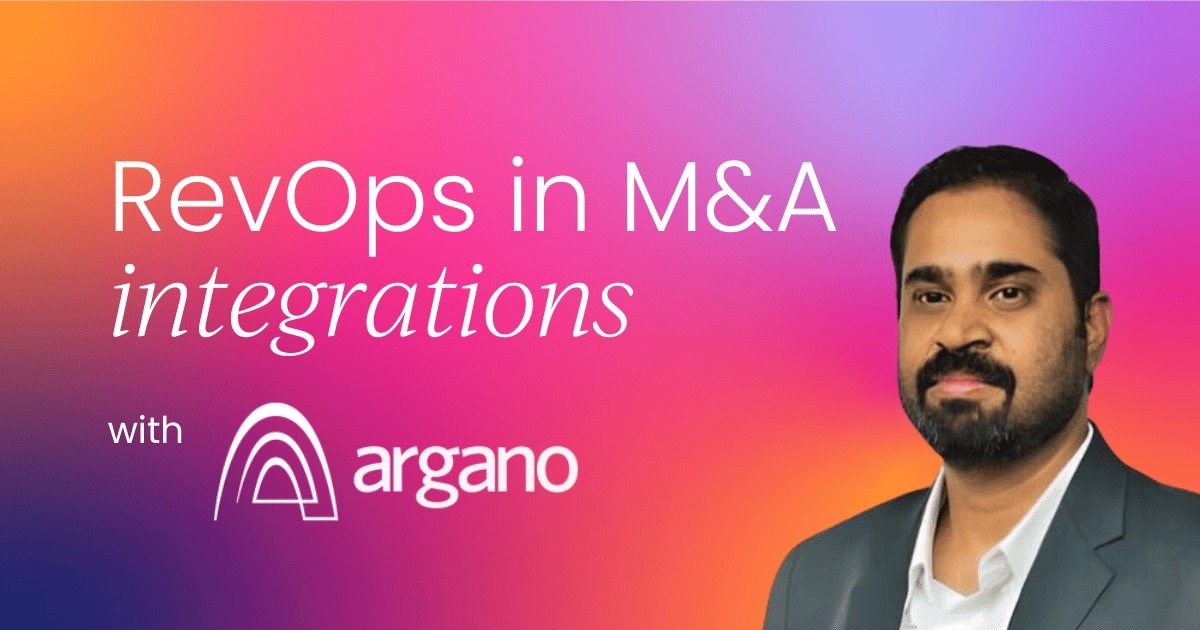Merger and acquisition (M&A) integrations can be long and daunting projects. If I were to draw an analogy, it’s like placing one mosaicked piece in the right place of a larger masterpiece you’ve been creating for months.
So, how do you get it right? There is no ‘one right way’ to achieve a smooth transition.
However, it’s crucial you have an effective team working together to create a machine that smoothly integrates with the larger business.
This article aims to answer the question: Why should RevOps be offered a seat at the table when tasked with integrating an organization into another or merging two organizations together?
This article covers:
Justifying a seat at the table
The primary goal for any M&A integration project is to maintain and enhance customer experience.
The project must ensure that during the integration process, the existing client experience doesn’t deteriorate. I’d argue the experience should be elevated, which will grow customer confidence and trust in the new organization being transitioned.
With that in mind, let’s ask ourselves, what value does RevOps bring to the table for such a project?
In my experience, this has two parts: external customer experience, and internal stakeholder and investor experience. Let’s discuss each in turn.
External customer experience
Streamlining the customer buying journey and aligning the revenue team (marketing, sales, and customer success) are key attributes on top of any RevOps leader’s mind. Both of these impact customer experience.
While bringing two companies together it’s very important to draw alignment and clearly redefine the customer journey. All variations in handoffs from one team to another should be ironed out so that the client experience is seamless and consistent across the organization as a transitioning or newly formed organization.
Also, during integration, there is always a risk of silos getting created with the introduction of new leaders or new teams being formed. RevOps leaders will play a vital role to enable teams to come together and function as one unit. This could be in terms of designing processes or bringing the teams on to integrated systems.
Therefore, to ensure a seamless transition, RevOps leaders play a key role in streamlining the customer journey during M&A integration.

Internal stakeholders and investor experience
The second important piece of M&A integration is maintaining and growing the confidence of executive leadership and investors. The major focus for these groups is data and reporting consistency that enables data-driven decision-making and ensures the company never falls away from the growth trajectory.
As the entities come together there will always be a transition phase from disparate systems. During the transition, understanding the data and normalizing new reporting processes is very important as reporting never stops. RevOps leaders are pivotal to this and will have to ensure that data is harmonized and ready for migration to the common platforms.
As a gatekeeper for the revenue tech stack and data RevOps leaders play a key role in ensuring executive leadership and investor delight.
Now that we have answered the “WHY,” let’s jump into “WHAT” is important for a RevOps leader to make this project a success.
Want to learn more about M&A? Check out Edtience's podcast episode.
Enabling success for M&A integrations
To be successful at combining the complexities of two organizations, stakeholders involved should ensure that they are approaching the goal with an open mindset and developing a solution that will enable scalability.
Open mindset
We all know there are a lot of emotions involved while working through the M&A integration process. Biases towards existing systems and processes are common.
Therefore, all stakeholders involved need to approach the project with an open mindset. This will help establish a culture that respects differences, builds trust, and encourages collaboration as a foundation.
Establishing a strong foundation opens doors to collaborative problem-solving, which in turn leads to the enhancement of customer and stakeholder confidence, which is the end goal for any M&A integration.
Once the strategy is agreed upon, the most difficult part is change management. Organizations need to empower stakeholders to run effective communication strategies that will not only build employee confidence and retention, but also commit to change adoption.
An open mindset also enables stakeholders to be nimble-footed to implement changes and make quick adjustments as and when required.

Enable scalability
Finally, the objective of M&As are to scale an organization, so integration activities should be designed with scalability in mind.
The consolidated entity must be more efficient and flexible than the parts of the whole factoring for future growth and expansion.
As a futuristic organization, efficiency should be key and therefore, all kinds of silos should be avoided between revenue teams to deliver operational productivity and cost efficiency.
Consolidation must factor in new risk scenarios and thus robust risk management is essential. This will ensure reduced downtime for systems and processes, and improved security protecting the organization when embarking on its journey to high-intensity growth.
The bottom line for all these activities is to ensure a seamless customer experience. Growth and scale are designed to deliver consistent product/service quality for customers. Therefore, enhancing capability with M&A must always result in customer delight.
Final thoughts
To conclude, RevOps leaders are responsible for working across all stakeholders impacting revenue for the organization across the customer journey.
Therefore, they are always in the best position to create value for the whole M&A integration process by leveraging synergies and implementing continuous improvement.
Got questions about M&A integrations? Join our Slack community and gain access to 2500+ revenue leaders expertise. 👇



 5 min read
5 min read
 Follow us on LinkedIn
Follow us on LinkedIn




